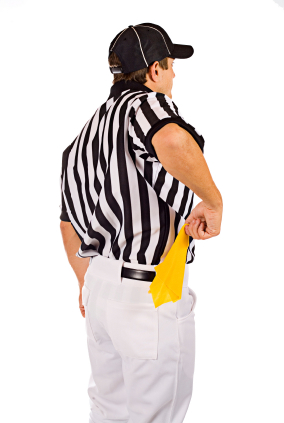Inspection and Quality. How the NFL Can Teach You About Lean.
So, it is a Sunday morning, and the outlook for today is bleak. You see, it is the bye week for my favorite football team–the Chicago Bears. I can handle the wait from the end of the season until the first game of the next one, but giving me a taste of football and then taking it away for a week is just plain cruel.
On the bright side, though, my wife is starting to show more interest in football, and has been asking me a lot of questions about the rules, strategies, and the business side of football. The other day we got to talking about the referees.

Inspection and Quality–What Football Referees Can Teach You
She was asking about if the refs get in trouble for missing calls, and what ‘ticky tack’ penalties were (they are the questionable nit-picky calls that normally don’t happen).
It got me thinking about Lean and how inspection and quality relate.
Think of the referees as the inspector at the end of a production line. They have one big advantage over factory inspectors in maintaining quality. Their upstream coworkers, the players, are highly motivated to avoid defects. There is an incentive for players to prevent the defects on their own. And with players preventing quality problems, inspection gets easier.
Inspection and Quality Rule #1: Inspection is easier if the production team is committed to delivering high quality.
It also got me thinking about the subjective nature of inspection and quality. In football, some ‘inspection’ is easy. Whether or not a player’s foot went out of bounds, or if a ball ‘crossed the plane’ of the goal line for a touchdown, or if the ball made it through the uprights are all examples of very clear situations where the referees can use inspection with a very low level of deviation among refs—they will all make the same call in most cases.
But what about things like ‘Unnecessary roughness’ (they have to judge if whether the roughness was necessary or not), or late hits (they have to decide if the hit was ‘on time’ or not). Other calls like holding are also very subjective. These types of penalties called in a much more inconsistent manner than the earlier group.
Inspection and Quality Rule #2: Inspection is easier if standard is very clear and doesn’t rely on subjective judgment.
One of the common themes in the first group of examples above is the use of visual controls. The sidelines clearly mark a standard. On the green is ‘in’; on the white is ‘out’. Using the same sort of visual controls in your inspection process can make the quality of your process much higher.
Inspection and Quality Rule #3: Inspection is easier if you use visual controls to help raise quality.
So now, I’d like you to do some homework. Spend next Sunday watching football. I know, it’s a rough assignment, but you can learn a lot about Lean by watching football.



0 Comments